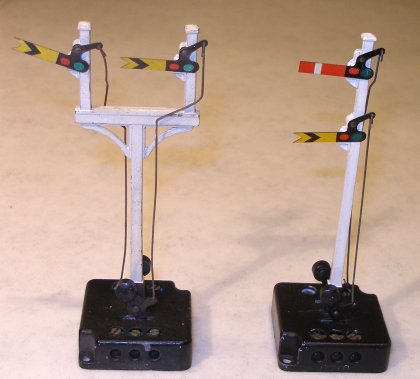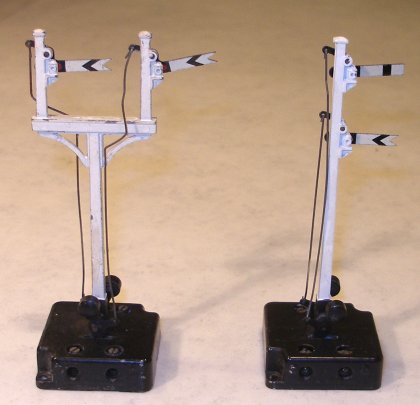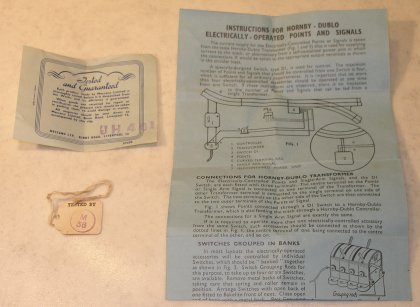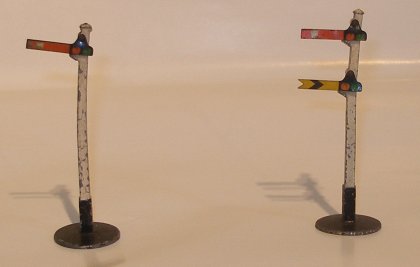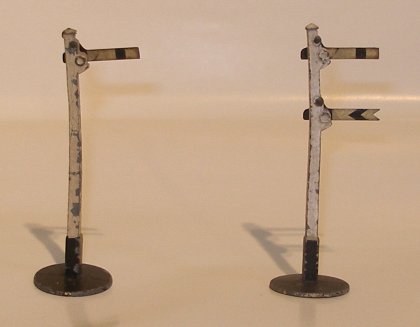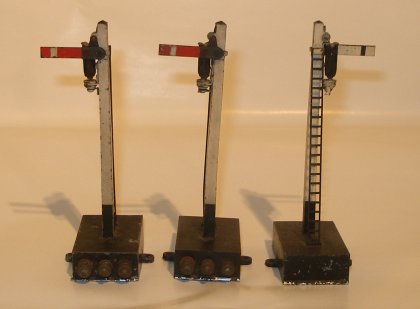
<<< Flipping Baseboards Solenoid point motor machines >>>
Out-of-the-box Working Semaphore Signals
A potted history
Hornby Dublo
Dinky
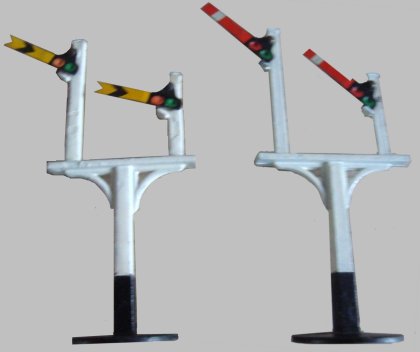

Trix Twin
Scale Model Equipment Co Ltd

Scale Model Signal in its box with instruction sheet.


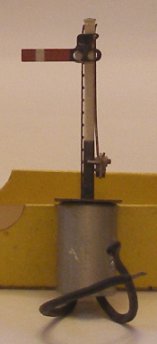
SME Distant signal front and back and short Home signal
When I was a kid living north of Liverpool in the 1950s there was only one model railway manufacturer worth talking about, namely Hornby and its OO Hornby Dublo system.
Like all kids of my generation, the manufacturer's catalogue was always eagerly sort each year when it was published, and there was always stuff in it that you always aspired to have, but were out of your price range.
And so it was with the signals. Hornby Dublo had a range of upper quadrant signals together with a set of colour light. For reasons that our unclear I had a full set of colour light signals, but never had either the manual or electrically worked semaphores. There were also a set of signals in the Dinky range, and a boxed set - suffering from the classic Meccano factory alloy fatigue - turned up on eBay recently. This would set Number 15. These are much smaller than the Hornby Dublo signals, being only 3 inches tall, against the 4.5 inches on the standard Hornby equivalent
I have to be honest at the time I dismissed the electrically worked signals with their large black bases as being toy like. I also felt - compared to the contemporary Crescent signals - that they seem rather flimsy.
Now in the early years of the Twenty First Century there is once again a set of Out-of-the-box (I hesitate to use the term Ready-to-Run!) working semaphore signals from Dapol on both 4mm and 2mm scales.
So how do these new offerings compare to what was being offered back in 65-years ago?
Hornby was not the only mass model railway manufacturer to produce working signals, as the Trix Twin system had working upper quadrant signals with glazed spectacles lit from the back. The arm and appearance was crude, but it was a definite echo of the modern Dapol signals.
The mechanics of these early Trix signals, and the electric Hornby semaphores that follow them suggest that Hornby essentially copied the design, although cleaned-up and neater.
On closer inspection of the Hornby signals - having ignored them for over 50 years - they may be closer to the prototype than I'd thought.
According to Michael Foster in The Hornby Companion Series, the Upper Quadrant single signal (D1) as either a Home or a Distant, and the double arm (D2) version dated from October 1938. The bracket signal (junction) (D3) followed in February 1939. Foster puts the launch of the electrically worked signals as December 1939.
The World War 2 saw production interrupted, and the electric signals reappeared in November 1952, with the electrically-operated bracket signal in July 1953.
Firstly the arms are very close in their critical dimensions to the modern MSE 4mm scale etches. If anything the Hornby arms are a tad to narrow, but good for length. The posts are all square - suggesting that Hornby took their inspiration for their Upper Quadrant signals from 'modernised' pre-grouping signals. As a Liverpool-based firm, their local prototypes would be the LNWR, LYR, Midland and Great Central, all of whom were driving lines towards the Liverpool docks. I had always assumed that as the posts - particularly the bracket signal - were clearly not LNWR, that they were likely to have been based on Midland types. But a study of signals in and around Todmorden found that they had in the main ex-LYR posts through to the end of steam, and that these looked surprisingly like the old Hornby signals. The bracket signal has the circle in the actual bracket omitted, but otherwise there is a striking similarity.
Dinky
Meccano Limited/Hornby Trains launched the Hornby Series Modelled Miniatures in 1931/2 as well as a series of Hollow cast lead figures to enrich Hornby O Gauge Trains, a carpet train set aimed at younger clients, the Set 21 Hornby Train was launched. According to the http://www.dinkytoys.ch Website, the first Dinky Toys cars came on the market in December of 1933, but they were not called Dinky Toys until April of 1934. Until then they where Modelled Miniatures, sold under the name of their original manufacturers, the Frank Hornby firm best known for its electric trains.
The Modelled Miniatures were, in fact, intended for use as accessories on model railroad platforms, and included figures of people and domestic animals, mailboxes, railway signals, and even some non-motorized railway rolling stock, in addition to the first of many motor vehicles.
In April 1934 when the Modelled Miniatures were re-branded as Meccano Dinky Toys, and Train set 21 was deleted and replaced initially with three new sets, followed by a fourth 2 months later. To accompany these were an extensive range of accessories. These included miniature luggage and truck; milk cans and truck; platofmr machine, pillar box and seats; as well as lineside notice boards (catch points, repairs, caution, shut off steam, whistle, tunnel); gradient and mile posts and station names(Newcastle, Doncaster, York, Grantham, Kings Cross and Edinburgh).
And then there were the signals. These were Upper Quadrant and mimicked the Hornby Dublo range in that there was a Home signal, Home and Distant and two brackets, one Home and one a Distant. These differed in that the dolls differed in length, with the taller doll being the left hand one. There was no operating mechanism, and the arm was stiffly riveted to the post, so that it could be moved up and down by hand.
Trix Twin
In or around 1938 the Trix Twin system launched the remote controlled signal. Two types were produced, catalogue Numbers 731 and 735; a distant and home signal with a working light which shone through a glazed spectacle plate. The manual version could also be had with a working light, such as ID # 727 'Lighted Bracket Signals - Distant: Manual'. It sees remarkable that 'splitting' distants (bracket signals with distant arms) figured in the Hornby Dublo, Dinky and Trix ranges. They were never particularly common on the real railway (a more typical formation would have also featured a Home arm as well a the two distants). They were intended to give advanced warning of the route to be taken at the next junction, and would be some considerable distance ahead of the junction home signal - at least the braking distance of the trains concerned. A distance far greater than the actual train, and in table top railway terms with a continuous run of a 6' x 4' board, there would be no where it could be realistically placed!
Scale Model Equipment Company Limited was formed in 1946, and remarkably is still trading, although now known as SME. It's original purpose was to manufacture scale models and detail parts for the model engineering trade. During the 1950's movement was away from model making to precision engineering, principally parts for aircraft instruments and business machines.
In 1959 Alastair Robertson-Aikman, the Company's founder, required a pick-up arm for his own use and an experimental model was built. It received such an enthusiastic reception from friends in the sound industry that it was decided to produce it commercially and the first SME precision pick-up arm appeared in September 1959. Production was 25 units per week composed entirely of individually machined components. At this time a new factory situated in Mill Road, Steyning was opened and the Company's name was changed to SME Limited, a less committal title to suit its new activities.
Triang
Mention should be made of the Tri-ang R43H & R43D single arm signals, available as either a Home or a Distant, and launched in 1955. This is actually a very good model, with a neat balance weight and ladder. It's only problem is that it is actually too big for true 4mm scale modelling - it would make an excellent S scale item. However, there was never an electric version.
Posted 15 September 2013
